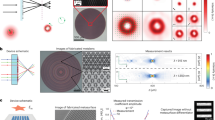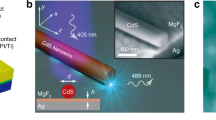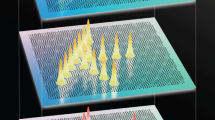Abstract
Nanolasers generate coherent light at the nanoscale. In the past decade, they have attracted intense interest, because they are more compact, faster and more power-efficient than conventional lasers. Thanks to these capabilities, nanolasers are now an emergent tool for a variety of practical applications. In this Review, we explain the intrinsic merits of nanolasers and assess recent progress on their applications, particularly for optical interconnects, near-field spectroscopy and sensing, optical probing for biological systems and far-field beam synthesis through near-field eigenmode engineering. We highlight the scientific and engineering challenges that remain for forging nanolasers into powerful tools for nanoscience and nanotechnology.
This is a preview of subscription content, access via your institution
Access options
Access Nature and 54 other Nature Portfolio journals
Get Nature+, our best-value online-access subscription
$29.99 / 30 days
cancel any time
Subscribe to this journal
Receive 12 print issues and online access
$259.00 per year
only $21.58 per issue
Buy this article
- Purchase on Springer Link
- Instant access to full article PDF
Prices may be subject to local taxes which are calculated during checkout





Similar content being viewed by others
References
Maiman, T. H. Stimulated optical radiation in ruby. Nature 187, 493–494 (1960).
What is NIF? https://lasers.llnl.gov/about/what-is-nif
Genet, C. & Ebbesen, T. W. Light in tiny holes. Nature 445, 39–46 (2007).
Schuller, J. A. et al. Plasmonics for extreme light concentration and manipulation. Nat. Mater. 9, 193–204 (2010).
Stockman, M. I. Nanoplasmonic sensing and detection. Science 348, 287–288 (2015).
Stockman, M. I. et al. Roadmap on plasmonics. J. Opt. 20, 043001 (2018).
McCall, S. L., Levi, A. F. J., Slusher, R. E., Pearton, S. J. & Logan, R. A. Whispering-gallery mode microdisk lasers. Appl. Phys. Lett. 60, 289–291 (1992).
Painter, O. et al. Two-dimensional photonic band-gap defect mode laser. Science 284, 1819–1821 (1999).
Johnson, J. C. et al. Single nanowire lasers. J. Phys. Chem. B 105, 11387–11390 (2001).
Eaton, S. W., Fu, A., Wong, A. B., Ning, C.-Z. & Yang, P. Semiconductor nanowire lasers. Nat. Rev. Mater. 1, 1–11 (2016).
Bergman, D. J. & Stockman, M. I. Surface plasmon amplification by stimulated emission of radiation: Quantum generation of coherent surface plasmons in nanosystems. Phys. Rev. Lett. 90, 027402 (2003).
Hill, M. T. et al. Lasing in metallic-coated nanocavities. Nat. Photon. 1, 589–594 (2007). This work demonstrates a metal-based nanolaser.
Nezha, M. P. et al. Room-temperature subwavelength metallo-dielectric lasers. Nat. Photon 4, 395–399 (2010).
Lu, C.-Y., Chang, S. W., Chuang, S. L., Germann, T. D. & Bimberg, D. Metal-cavity surface-emitting microlaser at room temperature. Appl. Phys. Lett. 96, 251101 (2010).
Kim, M. W. & Ku, P.-C. Lasing in a metal-clad microring resonator. Appl. Phys. Lett. 98, 131107 (2011).
Ding, K. et al. Room-temperature continuous wave lasing in deep-subwavelength metallic cavities under electrical injection. Phys. Rev. B 85, 041301(R) (2012).
Ding, K. et al. An electrical injection metallic cavity nanolaser with azimuthal polarization. Appl. Phys. Lett. 102, 041110 (2013).
Ding, K. et al. Record performance of electrical injection sub-wavelength metallic-cavity semiconductor lasers at room temperature. Opt. Express 21, 4728–4733 (2013).
Gu, Q. et al. Amorphous Al2O3 shield for thermal management in electrically pumped metallo-dielectric nanolasers. IEEE J. Quant. Electron. 50, 499–509 (2014).
Pan, S. H., Gu, Q., Amili, A. E., Vallini, F. & Fainman, Y. Dynamic hysteresis in a coherent high-β nanolaser. Optica 3, 1260–1265 (2016).
Oulton, R. F. et al. Plasmon lasers at deep subwavelength scale. Nature 461, 629–632 (2009). This work demonstrates a plasmonic nanowire laser.
Lu, Y. J. et al. Plasmonic nanolaser using epitaxially grown silver film. Science 337, 450–453 (2012).
Liu, X., Zhang, Q., Yip, J. N., Xiong, Q. & Sum, T. C. Wavelength tunable single nanowire lasers based on surface plasmon polariton enhanced Burstein–Moss effect. Nano Lett. 13, 5336–5343 (2013).
Wu, X. et al. Hybrid photon–plasmon nanowire lasers. Nano Lett. 13, 5654–5659 (2013).
Sidiropoulos, T. et al. Ultrafast plasmonic nanowire lasers near the surface plasmon frequency. Nat. Phys. 10, 870–876 (2014).
Zhang, Q. et al. A room temperature low-threshold ultraviolet plasmonic nanolaser. Nat. Commun. 5, 4953 (2014).
Lu, Y. J. et al. All-color plasmonic nanolasers with ultralow thresholds: autotuning mechanism for single-mode lasing. Nano Lett. 14, 4381–4388 (2014).
Ho, J. F. et al. Low-threshold near-infrared GaAs–AlGaAs core–shell nanowire plasmon laser. ACS Photonics 2, 165–171 (2015).
Ho, J. et al. A nanowire-based plasmonic quantum dot laser. Nano Lett. 16, 2845–2850 (2016).
Chou, Y. H. et al. High-operation-temperature plasmonic nanolasers on single-crystalline aluminium. Nano Lett. 16, 3179–3186 (2016).
Yu, H. C. et al. Organic–inorganic perovskite plasmonic nanowire lasers with a low threshold and a good thermal stability. Nanoscale 8, 19536–19540 (2016).
Zhang, Q. et al. Wavelength tunable plasmonic lasers based on intrinsic self-absorption of gain material. ACS Photonics 4, 2789–2796 (2017).
Yu, H. et al. Influence of silver film quality on the threshold of plasmonic nanowire lasers. Adv. Optical Mater. 5, 1600856 (2017).
Lee, C. T. et al. Low-threshold plasmonic lasers on a single-crystalline epitaxial silver platform at telecom wavelength. ACS Photonics 4, 1431–1439 (2017).
Kress, S. J. P. et al. A customizable class of colloidal-quantum-dot spasers and plasmonic amplifiers. Sci. Adv. 3, e1700688 (2017).
Lu, J. et al. Plasmon-induced accelerated exciton recombination dynamics in ZnO/Ag hybrid nanolasers. ACS Photonics 4, 2419–2424 (2017).
Liu, S. et al. Molecular beam epitaxy of single-crystalline aluminum film for low threshold ultraviolet plasmonic nanolasers. Appl. Phys. Lett. 112, 231904 (2018).
Hill, M. T. et al. Lasing in metal–insulator–metal sub-wavelength plasmonic waveguides. Opt. Express 17, 11107–11112 (2009).
Nguyen, N. B. et al. Hybrid gap plasmon GaAs nanolasers. Appl. Phys. Lett. 111, 261107 (2017).
Noginov, M. A. et al. Demonstration of a spaser-based nanolaser. Nature 460, 1110–1112 (2009).
Meng, X. G., Kildishev, A. V., Fujita, K., Tanaka, K. & Shalaev, V. M. Wavelength-tunable spasing in the visible. Nano Lett. 13, 4106–4112 (2013).
Zhang, C. et al. Plasmonic lasing of nanocavity embedding in metallic nanoantenna array. Nano Lett. 15, 1382–1387 (2015).
Galanzha, E. I. Spaser as a biological probe. Nat. Commun. 8, 15528 (2017). This work introduces a spaser for biological probing.
Yu, K., Lakhani, A. & Wu, M. C. Subwavelength metal-optic semiconductor nanopatch lasers. Opt. Express 18, 8790–8799 (2010).
Kwon, S. H. et al. Subwavelength plasmonic lasing from a semiconductor nanodisk with silver nanopan cavity. Nano Lett. 10, 3679–3683 (2010).
Ma, R. M., Oulton, R. F., Sorger, V. J., Bartal, G. & Zhang, X. Room-temperature sub-diffraction-limited plasmon laser by total internal reflection. Nat. Mater. 10, 110–113 (2011).
Ma, R.-M., Ota, S., Li, Y., Yang, S. & Zhang, X. Explosives detection in a lasing plasmon nanocavity. Nat. Nanotech. 9, 600–604 (2014).
Wang, X.-Y. et al. Lasing enhanced surface plasmon resonance sensing. Nanophotonics 5, 52–58 (2016). This work introduces plasmonic nanolaser for sensing in a biochemical environment.
Guo, C.-C., Xiao, J.-L., Yang, Y.-D., Zhu, Z.-H. & Huang, Y.-Z. Lasing characteristics of wavelength-scale aluminum/silica coated square cavity. IEEE Photonics Technol. Lett. 28, 217–220 (2016).
Liu, N. Lithographically defined, room temperature low threshold subwavelength red-emitting hybrid plasmonic lasers. Nano Lett. 16, 7822–7828 (2016).
Chen, H.-Z. et al. Imaging the dark emission of spasers. Sci. Adv. 3, e1601962 (2017).
Wang, S. et al. High-yield plasmonic nanolasers with superior stability for sensing in aqueous solution. ACS Photonics 4, 1355–1360 (2017).
Wang, S. et al. Unusual scaling laws for plasmonic lasers beyond diffraction limit. Nat. Commun. 8, 1889 (2017). This work clarifies the viability of metal confinement and feedback strategies in laser technology.
Huang, C. et al. Formation of lead halide perovskite based plasmonic nanolasers and nanolaser arrays by tailoring the substrate. ACS Nano 12, 3865–3874 (2018).
Lakhani, A. M., Kim, M. K., Lau, E. K. & Wu, M. C. Plasmonic crystal defect nanolaser. Opt. Express 19, 18237–18245 (2011).
Keshmarzi, E. K., Tait, R. N. & Berini, P. Single-mode surface plasmon distributed feedback lasers. Nanoscale 10, 5914–5922 (2018).
Cheng, P.-J. et al. High-performance plasmonic nanolasers with a nanotrench defect cavity for sensing applications. ACS Photonics 5, 2638–2644 (2018).
Khajavikhan, M. et al. Thresholdless nanoscale coaxial lasers. Nature 482, 204–207 (2012). This work shows a nanolaser with spontaneous emission coupling factor close to unity.
Hayenga, W. E. et al. Second-order coherence properties of metallic nanolasers. Optica 3, 1187–1193 (2016).
Ma, R. M., Yin, X. B., Oulton, R. F., Sorger, V. J. & Zhang, X. Multiplexed and electrically modulated plasmon laser circuit. Nano Lett. 12, 5396–5402 (2012). This work demonstrates a waveguide-embedded plasmonic nanolaser.
Chou, Y.-H. et al. Ultracompact pseudowedge plasmonic lasers and laser arrays. Nano Lett. 18, 747–753 (2018).
Symonds, C. et al. Confined Tamm plasmon lasers. Nano Lett. 13, 3179–3184 (2013).
Lheureux, G. Polarization-controlled confined Tamm plasmon lasers. ACS Photonics 2, 842–848 (2015).
Shen, K. C. et al. Deep-ultraviolet hyperbolic metacavity laser. Adv. Mater. 30, 1706918 (2018).
Wang, X.-Y., Chen, H.-Z., Wang, S., Zhang, S. & Ma, R.-M. Chiral-reversing vortex radiation from a single emitter by eigenstates phase locking. https://arXiv.org/1707.01055 (2017).
Zhou, W. et al. Lasing action in strongly coupled plasmonic nanocavity arrays. Nat. Nanotech. 8, 506–511 (2013). This work reports a plasmonic array laser with a configuration of metal particles.
Van Beijnum, F. et al. Surface plasmon lasing observed in metal hole arrays. Phys. Rev. Lett. 110, 206802 (2013). This work reports a plasmonic array laser with a configuration of metal holes.
Yang, A. K. et al. Real-time tunable lasing from plasmonic nanocavity arrays. Nat. Commun. 6, 6939 (2015).
Schokker, A. H. & Koenderink, A. F. Lasing in quasi-periodic and aperiodic plasmon lattices. Optica 3, 686–693 (2016).
Tenner, V. T., de Dood, M. J. A. & van Exter, M. P. Measurement of the phase and intensity profile of surface plasmon laser emission. ACS Photonics 3, 942–946 (2016).
Wang, D. et al. Band-edge engineering for controlled multi-modal nanolasing in plasmonic superlattices. Nat. Nanotech. 12, 889–894 (2017).
Wang, D. et al. Stretchable nanolasing from hybrid quadupole plasmons. Nano Lett. 18, 4549–4555 (2018).
Kim, H., Lee, W.-J., Farrell, A. C., Balgarkashi, A. & Huffaker, D. L. Telecom-wavelength bottom-up nanobeam lasers on silicon-on-insulator. Nano Lett. 17, 5244–5250 (2017).
Ha, S. T. Directional lasing in resonant semiconductor nanoantenna arrays. Nat. Nanotech. https://doi.org/10.1038/s41565-018-0245-5 (2018). This work demonstrates a dielectric nanoparticle array laser.
Yokoyama, H. & Brorson, S. Rate equation analysis of microcavity lasers. J. Appl. Phys. 66, 4801–4805 (1989).
Björk, G. & Yamamoto, Y. Analysis of semiconductor microcavity lasers using rate equations. IEEE J. Quant. Electron. 27, 2386–2396 (1991).
Yokoyama, H. et al. Controlling spontaneous emission and threshold-less laser oscillation with optical microcavities. Opt. Quant. Electron. 24, S245–S272 (1992).
Purcell, E. M. Spontaneous emission probabilities at radio frequencies. Phys. Rev. 69, 681 (1946).
van Exter, M. P., Nienhuis, G. & Woerdman, J. P. Two simple expressions for the spontaneous emission factor β. Phys. Rev. A 54, 3553 (1996).
Altug, H., Englund, D. & Vuckovic, J. Ultrafast photonic crystal nanocavity laser. Nat. Phys. 2, 484–488 (2006).
Lau, E. K., Lakhani, A., Tucker, R. S. & Wu, M. C. Enhanced modulation bandwidth of nanocavity light emitting devices. Opt. Express 17, 7790 (2009).
Ni, C.-Y. A. & Chuang, S. L. Theory of high-speed nanolasers and nanoLEDs. Opt. Express 20, 16450 (2012).
Pan, S. H., Deka, S. S., Amili, A. E., Gu, Q. & Fainman, Y. Nanolasers: second-order intensity correlation, direct modulation and electromagnetic isolation in array architectures. Progr. Quant. Electron. 59, 1–18 (2018).
Wang, S., Chen, H.-Z. & Ma, R.-M. High performance plasmonic nanolasers with external quantum efficiency exceed 10%. Nano Lett. https://doi.org/10.1021/acs.nanolett.8b03890 (2018).
Sauvan, C., Hugonin, J. P., Maksymov, I. S. & Lalanne, P. Theory of the spontaneous optical emission of nanosize photonic and plasmon resonators. Phys. Rev. Lett. 110, 237401 (2013).
Cisco. The Zettabyte Era: Trends and Analysis (Cisco, 2017); https://www.cisco.com/c/en/us/solutions/collateral/service-provider/visual-networking-index-vni/vni-hyperconnectivity-wp.html
Tucker, R. S. Green optical communications part II: energy limitations in networks. IEEE J. Sel. Top. Quant. Electron. 17, 261–274 (2011).
Tatum, J. A. et al. VCSEL-based interconnects for current and future data centers. J. Lightw. Technol. 33, 727–732 (2015).
Miller, D. A. B. Device requirements for optical interconnects to silicon chips. Proc. IEEE 97, 1166–1185 (2009).
Khurgin, J. B. & Sun, G. Comparative analysis of spasers, vertical-cavity surface-emitting lasers and surface-plasmonemitting diodes. Nat. Photon 8, 468–473 (2014).
Strologas, J. & Hess, K. Diffusion capacitance and laser diodes. IEEE Trans. Electron Devices 51, 506–509 (2004).
Agrawal, G. P. Fiber-optic Communication Systems. 3rd edition (Wiley, New York, 2002).
Coldren, L. A. Diode Lasers and Photonic Integrated Circuits. 2nd edition (Wiley, New York, 2012).
Kim, M.-K., Lakhani, A. M. & Wu, M. C. Efficient waveguide-coupling of metal-clad nanolaser cavities. Opt. Express 19, 23504–23512 (2011).
Dolores-Calzadilla, V. et al. Waveguide-coupled nanopillar metal-cavity light-emitting diodes on silicon. Nat. Commun. 8, 14323 (2017).
Homola, J. Surface Plasmon Resonance Based Sensors (Springer, Berlin, 2006).
Zhu, W. et al. Surface plasmon polariton laser based on a metallic trench Fabry–Pérot resonator. Sci. Adv. 3, e1700909 (2017).
Gather, M. C. & Yun, S. H. Single-cell biological lasers. Nat. Photon. 5, 406–410 (2011).
Fan, X. & Yun, S. H. The potential of optofluidic biolasers. Nat. Methods 11, 141–147 (2014).
Humar, M. & Yun, S. H. Intracellular microlasers. Nat. Photon. 9, 572–576 (2015).
McGloin, D. Cellular lasers. Nat. Photon. 9, 559–560 (2015).
Schubert, M. Lasing within live cells containing intracellular optical microresonators for barcode-type cell tagging and tracking. Nano Lett. 15, 5647–5652 (2015).
Chen, Y.-C., Chen, Q. & Fan, X. Lasing in blood. Optica 3, 809 (2016).
Chen, Y.-C. et al. Laser-emission imaging of nuclear biomarkers for high-contrast cancer screening and immunodiagnosis. Nat. Biomed. Eng. 1, 724–735 (2017).
Martino, N. et al. Micron-sized laser particles for massively multiplexed cellular labelling and tracking. In Proc. CLEO JTh5C.6 (OSA, 2018).
Cho, S., Humar, M., Martino, N. & Yun, S. H. Laser particle stimulated emission microscopy. Phys. Rev. Lett. 117, 193902 (2016).
Liu, X. W. et al. Fluorescent nanowire ring illumination for wide-field far-field subdiffraction imaging. Phys. Rev. Lett. 118, 076101 (2017).
Allen, L., Beijersbergen, M. W., Spreeuw, R. J. C. & Woerdman, J. P. Orbital angular-momentum of light and the transformation of Laguerre–Gaussian laser modes. Phys. Rev. A 45, 8185 (1992).
Yao, A. M. & Padgett, M. J. Orbital angular momentum: origins, behavior and applications. Adv. Opt. Photonics 3, 161 (2011).
Miao, P. et al. Orbital angular momentum microlaser. Science 353, 464 (2016).
Wang, X.-Y., Chen, H.-Z., Li, Y., Li, B. & Ma, R.-M. Microscale vortex laser with controlled topological charge. Chin. Phys. B 25, 124211 (2016).
Zhen, B. et al. Topological nature of optical bound states in the continuum. Phys. Rev. Lett. 113, 257401 (2014).
Kodigala, A. et al. Lasing action from photonic bound states in continuum. Nature 541, 196–199 (2017).
Bahari, B. et al. Nonreciprocal lasing in topological cavities of arbitrary geometries. Science 358, 636–640 (2017).
Bandres, M. A. et al. Topological insulator laser: experiments. Science 356, eaar4005 (2018).
Zhao, H. et al. Topological hybrid silicon microlasers. Nat. Commun. 9, 981 (2018).
Parto, M. et al. Edge-mode lasing in 1D topological active arrays. Phys. Rev. Lett. 120, 113901 (2018).
Wu, L.-H. & Hu, X. Scheme for achieving a topological photonic crystal by using dielectric material. Phys. Rev. Lett. 114, 223901 (2015).
Zheludev, N. I., Prosvirnin, S. L., Papasimakis, N. & Fedotov, V. A. Lasing spaser. Nat. Photon . 2, 351–354 (2008).
Acknowledgements
This work was supported by the National Natural Science Foundation of China (grant nos. 11574012, 11774014, 61521004), the Youth 1000 Talents Plan Fund, UK Engineering and Physical Sciences Research council (EP/M013812/1), the Leverhulme Trust (RPG-2016-064) and the EU’s Marie Skłodowska-Curie Actions (PIRG08-GA-2010-277080).
Author information
Authors and Affiliations
Corresponding author
Ethics declarations
Competing interests
The authors declare no competing interests.
Additional information
Publisher’s note: Springer Nature remains neutral with regard to jurisdictional claims in published maps and institutional affiliations.
Rights and permissions
About this article
Cite this article
Ma, RM., Oulton, R.F. Applications of nanolasers. Nature Nanotech 14, 12–22 (2019). https://doi.org/10.1038/s41565-018-0320-y
Received:
Accepted:
Published:
Issue Date:
DOI: https://doi.org/10.1038/s41565-018-0320-y
This article is cited by
-
Ultra-low threshold continuous-wave quantum dot mini-BIC lasers
Light: Science & Applications (2023)
-
Reconfigurable moiré nanolaser arrays with phase synchronization
Nature (2023)
-
Resonant perovskite solar cells with extended band edge
Nature Communications (2023)
-
High-Q lasing via all-dielectric Bloch-surface-wave platform
Nature Communications (2023)
-
Finite-element Analysis of Low-threshold Perovskite Nano-lasers Based on Hybrid Plasmonic Waveguides
Plasmonics (2023)



